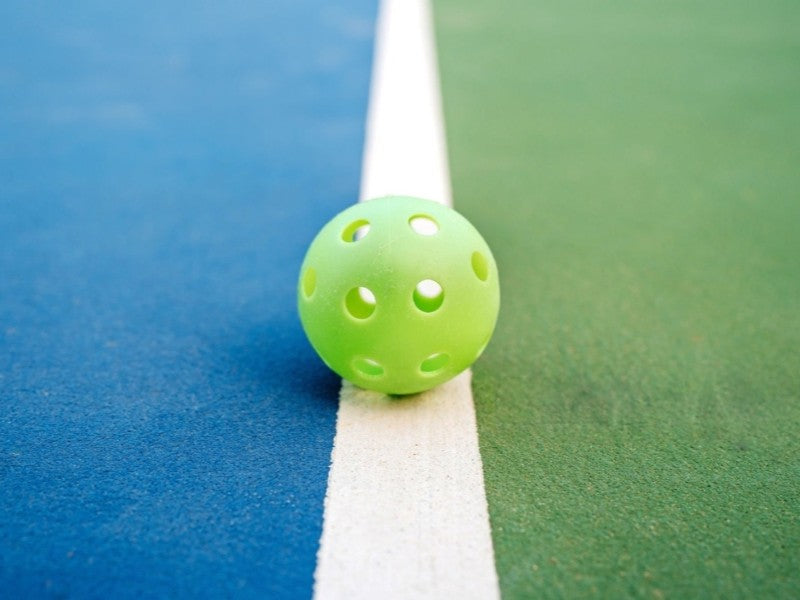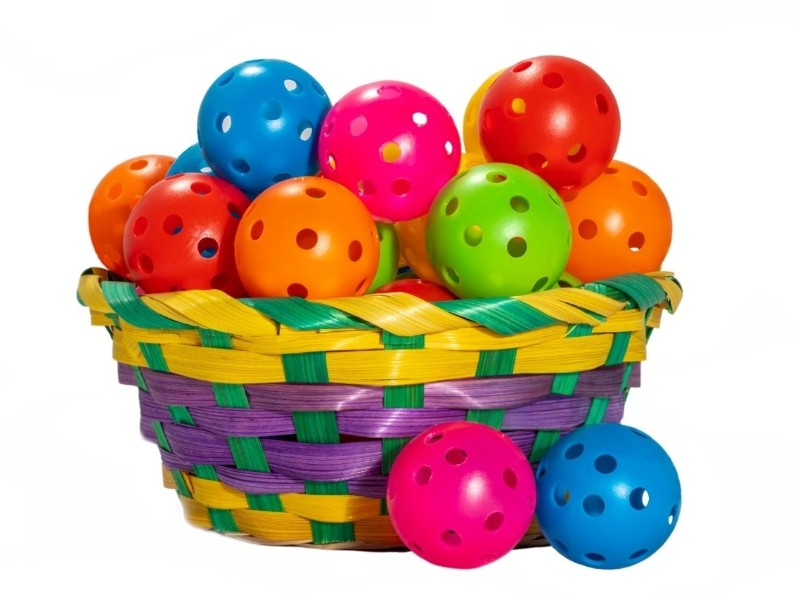If you are new to the game of pickleball, you may have wondered why some players talk about “indoor balls” and “outdoor balls” as if they are completely different equipment. After all, aren’t all pickleballs just plastic balls with holes? At first glance, yes. But in practice, the difference between indoor and outdoor pickleballs is significant enough to change the pace of the game, the durability of your gear, and even your enjoyment of play.
Indoor and outdoor pickleballs are engineered for their distinct respective playing settings. Indoor pickleballs are built to perform on smooth, controlled surfaces such as gym floors, while outdoor pickleballs must withstand rough courts, wind, sun, and fluctuating temperatures. Choosing the wrong type can result in faster wear, inconsistent bounce, or even frustration when you cannot control shots the way you expect.
How Indoor and Outdoor Pickleballs Are Made: Materials & Construction
One of the most important things to know is that not all pickleballs are produced the same way. Both indoor and outdoor versions are typically made from durable plastic polymers, but the details of their design and construction lead to different performance characteristics.
1.Materials and Additives
The majority of pickleballs are constructed using polyethylene or comparable thermoplastic materials. For outdoor balls, manufacturers often add UV stabilizers and impact modifiers to resist sunlight damage and cracking. Indoor balls do not require the same level of UV resistance, so they can be slightly softer and lighter.
2.Hole Count and Pattern
The most visible difference is in the number and size of holes.
- Indoor pickleballs generally have 26 larger holes, allowing smoother flight indoors where wind is not a factor.
- Outdoor pickleballs usually feature 40 smaller holes, which helps reduce wind interference and keeps the ball’s path more predictable outside.
These patterns are carefully tested, as hole size directly affects aerodynamics, spin potential, and flight stability.
3.Wall Thickness and Hardness
Outdoor pickleballs feature thicker walls and sturdier plastic, built to hold up against rough asphalt or concrete surfaces. This makes them bounce faster and feel “harder” on the paddle. Indoor balls, by contrast, are slightly thinner and softer, which gives them a touch more control on smooth wooden floors.
4.Seam and Tolerances
Rotationally molding is the standard process for most pickleballs, which results in a seam at the junction of their two halves. Outdoor balls are engineered with stronger seams to resist splitting from repeated high-speed hits. Indoor balls may not need that reinforcement, which is why they often last longer but eventually get “soft spots” rather than cracks.
5.Standards and Approvals
If you’re competing, note that tournament play requires USAPA-approved balls, which are tested for diameter, weight, bounce, and hardness. While recreational players can use any brand, serious players benefit from sticking to approved models to ensure consistency.
Performance Differences: Flight, Bounce, Durability, and Sound
Even if you never study the construction details, you’ll notice the difference between indoor and outdoor pickleballs the moment you play with them. Their behavior during play is what matters most for players.
1.Flight and Aerodynamics
- Indoor pickleballs are lighter (around 0.8 oz) and, with their larger holes, encounter less drag indoors. This results in a slower, more controlled flight. Players often find them easier to place accurately, but harder to hit with power.
- Outdoor pickleballs are slightly heavier (around 0.9 oz) and have more holes. This makes them cut through the air better in windy conditions, though they tend to travel faster. Outdoor balls can feel “livelier,” requiring quicker reflexes.
2.Bounce and Speed
On hardwood or smooth indoor surfaces, the softer indoor balls bounce consistently and with less skid. This design encourages extended rallies and places greater focus on finesse rather than raw power. Outdoor balls, bouncing on concrete or asphalt, are livelier and higher bouncing. The result is a faster-paced game that often ends points sooner.
3.Durability and Lifespan
Durability is one of the clearest differences.
- Indoor pickleballs are less prone to cracking, though they might form soft spots with prolonged use. Their lifespan ranges from weeks to months, depending on how often they’re used.
- Outdoor pickleballs take more abuse from rough surfaces and temperature shifts. They may crack along the seam after several sessions, sometimes even within a few games under cold conditions.
Because of this, many outdoor players buy balls in bulk, accepting a shorter lifespan as part of the game.
4.Noise and Playability
Noise is frequently neglected yet crucial in residential areas. Due to their harder composition, outdoor pickleballs create a louder “pop” when hitting the paddle or court. Some communities with noise concerns specifically restrict which balls can be used. Indoor balls, being softer, are quieter—another reason they are chosen for gym and recreation center play.
5.Spin and Control
Finally, indoor balls, being lighter and with fewer holes, tend to accept spin more easily. This makes them ideal for practicing finesse shots such as dinks and slices. Outdoor balls, designed for speed and stability, are harder to spin consistently.
6.How Surface and Environment Change Ball Behavior
Even the best-designed ball will behave differently depending on where you play. This is why understanding the difference between indoor and outdoor pickleballs also means considering the court and environment.
7.Surface Types: Hardwood vs. Asphalt vs. Concrete
- Indoor pickleball courts typically consist of hardwood, vinyl, or smooth synthetic surfaces. These surfaces are gentle on pickleballs, allowing a consistent and slightly lower bounce. Players often find they can rely on touch shots more indoors.
- Outdoor courts, typically asphalt or concrete, are much rougher. They cause the ball to bounce higher and wear faster. Outdoor players notice scuffing and seam stress within just a few sessions.
8.Temperature and Humidity Effects
Plastic behaves differently in various climates.
- Cold weather makes outdoor pickleballs brittle, leading to cracks even after a few games.
- Hot weather softens the plastic, reducing bounce and sometimes warping the ball.
- Humidity affects indoor play less, but it can cause slight surface slickness that changes ball response.
This is why experienced players often rotate their ball stock depending on the season.
9.Wind and Outdoor Conditions
Wind is the most obvious outdoor factor. Without smaller holes and added weight, a pickleball would drift uncontrollably. Even with proper outdoor balls, wind can still push shots off course, forcing players to adjust footwork and timing. Indoors, this variable is eliminated, making the game more predictable.
Practical Tests: How to Choose, Test, and Maintain Your Pickleballs

Whether you are buying for personal play or stocking up for a club, it helps to know how to test pickleballs before committing to a bulk purchase.
Simple At-Home Tests
Here are a few practical steps any player can perform:
-
Weight and Roundness Check
Use a digital scale to confirm weight. Roll the ball on a flat surface to check if it’s perfectly round. -
Bounce Test
Drop the ball from 78 inches (the USAPA standard) and measure the bounce height. Approved balls should bounce between 30–34 inches. -
Flight Test
Hit several baseline drives and observe the ball’s trajectory. Indoor balls should fly slower and allow more spin; outdoor balls should stay straighter and faster. -
Seam Inspection
Look closely at the seam after a few games. Cracks or splits indicate poor durability.
Tip: Conduct these tests on both hardwood (if available) and outdoor concrete to see how the same ball reacts in different settings.
Maintenance & Storage Best Practices
- Rotate balls regularly to spread wear evenly.
- Avoid extreme temperatures; store balls indoors away from direct sunlight or freezing garages.
- Clean balls with mild soap and water to remove dirt that accelerates wear.
When to Retire a Ball
Indoor balls become “mushy” over time, losing bounce and spin response. Outdoor balls usually split at the seam or develop visible cracks. If a ball no longer bounces predictably or feels inconsistent, it’s time to replace it.
Buying Guide & Recommendations
The market is full of pickleball options, which can be overwhelming. This section will help narrow your choices based on your level, playing environment, and budget.
1.Which Ball for Which Player
- Recreational players: Durability is less critical; buy value packs of 6–12 balls.
- Club managers: Balance cost and longevity; consider mixed indoor and outdoor sets for different courts.
- Tournament players: Always choose USAPA-approved models for consistency and eligibility.
2.Price and Value Tiers
- Budget balls ($1–$2 each): Good for casual practice but may not last long outdoors.
- Mid-tier ($2–$3 each): Balanced durability and performance; most common choice for clubs.
- Tournament grade ($3–$5 each): Highest consistency, approved for official play.
3.Brand and Model Examples
Without endorsing any one manufacturer, here are typical categories you’ll see:
- Indoor control-focused models with 26 holes and softer walls.
- Outdoor competition models with 40 holes and reinforced seams.
- Hybrid practice balls designed for both surfaces but not optimized for tournament play.
4.Where to Buy and What to Check
- Sporting goods stores: Easier to handle balls physically before buying.
- Online marketplaces: Offer bulk discounts but watch out for counterfeit or non-approved products.
- Direct from brands: Reliable for ensuring USAPA certification.
When buying, always check:
- Hole pattern (26 vs. 40)
- Approval markings (USAPA stamp for tournaments)
- Pack size (bulk often reduces per-ball cost)
Quick Comparison and Checklist
By now, you’ve seen that the difference between indoor and outdoor pickleballs is not a minor detail—it shapes how the game feels and how long your equipment lasts.
- Indoor pickleballs: 26 holes, softer, slower, longer lifespan, better spin.
- Outdoor pickleballs: 40 holes, harder, faster, shorter lifespan, built for wind and rough surfaces.
Quick Checklist for Players
- Identify your primary playing environment (indoor gym or outdoor courts).
- Select the right hole pattern (26 for indoor, 40 for outdoor).
- Test bounce and roundness before bulk purchases.
- Rotate and store balls properly to extend lifespan.
- Replace balls once cracks, warps, or inconsistent bounce appear.
Choosing the correct ball for your conditions will help you play more consistently, reduce frustration, and get the most value from your purchase.
FAQs
1. Can I use indoor pickleballs outside?
Yes, but they will wear out quickly and drift more in the wind. Not recommended for regular outdoor play.
2. Do outdoor pickleballs bounce higher than indoor ones?
Generally, yes. Harder plastics and rougher surfaces make them livelier.
3. Why do my outdoor pickleballs crack so fast in winter?
Cold temperatures make the plastic brittle. Warm the balls indoors before use or switch brands designed for cold weather.
4. How long does a pickleball last?
Indoor balls may last weeks or months, while outdoor balls often need replacement after several sessions.
5. Are all pickleballs USAPA-approved?
No. Only models tested and approved by the governing body are legal for tournament play. Check for the official stamp.









Leave a comment
This site is protected by hCaptcha and the hCaptcha Privacy Policy and Terms of Service apply.